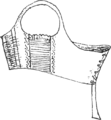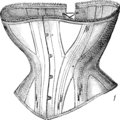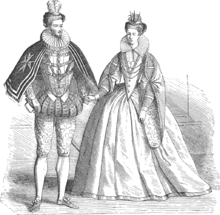History of corsets

The corset has been an indispensable supportive undergarment for women, in Europe for several centuries, evolving as fashion trends have changed and being known, depending on era and geography, as bodies, stays and corsets. The appearance of the garment represented a change from people wearing clothes to fit their bodies to changing the shape of their bodies to fit their fashionable clothing.[2]
The corset first became popular in sixteenth-century Europe, reaching the zenith of its popularity in the Victorian era.[citation needed] While the corset has typically been worn as an undergarment, it has occasionally been used as an outer-garment; corsets as outer-garments can be seen in the national dress of many European countries.[3]: 22
Etymology[]
The English word corset is derived from the Old French word corps and the diminutive of body, which itself derives from corpus—Latin for body. The term "corset” was in use in the late 14th century, from the French "corset" which meant "a kind of laced bodice." The meaning of it as a "stiff supporting so constricting undergarment for the waist, worn chiefly by women to shape the figure," dates from 1795.[4][5]
In English, the term "bodies" or "pair of bodies" was used until the 1680s when it was replaced by the term "stays."[6] The term "corset" appears in the middle of the eighteenth century, and was used until the early twentieth century.
Before the 16th century[]

The earliest known representation of a possible corset appears on a figurine from Minoan art made circa 1600 BCE. The article of clothing depicted might be perceived as a corset, but is worn as an outer garment, and leaves the breasts exposed.[3]
Corsets have been used for centuries among certain tribes of the Caucasus: Circassians and Abkhaz. They were used to "beautify" women and also to ensure modesty. Corsets were laced tightly with as many as fifty laces, and had to be worn from childhood until the wedding night. When the marriage was consummated, a groom had to slowly and carefully undo each lace to demonstrate self-control.[7][8]
16th and 17th centuries[]

Corsets were worn for the longest time and originated as stays. Corsets were worn on linen undergarments under all of the other layers of clothing. [3]: 22 The women of the French court saw this corset as "indispensable to the beauty of the female figure."[9] Corsets of this time were often worn with a farthingale that held out the skirts in a stiff cone. The corsets turned the upper torso into a matching but inverted cone shape. These corsets had shoulder straps and ended in flaps at the waist. They flattened the bust, and in so doing, pushed the breasts up.
The intense tight-lacing that is seen in later centuries was not possible at this time, as the holes through which the laces were threaded were sewn by hand, and would tear if put under too much strain. Therefore the emphasis of the stays was less on the smallness of the waist than on the contrast between the rigid flatness of the bodice front and the curving tops of the breasts peeking over the top of the corset. These corsets were typically made out of layered fabric, stiffened with glue, and were tightly laced. While a few surviving corsets exist that are structured with steel or iron, these are generally considered to have been either orthopedic or novelty constructions and were not worn as part of mainstream fashion.[10]
During the sixteenth and seventeenth centuries bodies, as corsets were known then, were typically worn as both underwear and outerwear. There are many examples of bodies from these centuries that have detachable sleeves.[11] Whalebone (baleen) was frequently used in bodies to maintain their stiff appearance. Bents (reeds) were also common. A busk, typically made of wood, horn, ivory, metal, or whalebone, was added to stiffen the front of the bodice. It was then carved and shaped into a thin knife shape and inserted into a pouch in the front of the bodice, then fastened and held into place by ribbon, so that the busk could be easily removed and replaced.[3]: 29 The busk was often used for special occasions and events, and was sometimes presented to a woman by a suitor as a prize when he was interested in a female.[12] The front of the corset was typically covered by a "stomacher," a stiff, V-shaped structure that was worn on the abdomen for decorative purposes.[10]
Since the mid-Victorian period, the busk has been made of steel and consists of two parts, one for each side. One side has studs and the other eyes so that the corset can be easily fastened and unfastened from the front.[3]: 27 During the late 1500s, when whalebone was used at the sides and back of the corset, the corset was laced up at the front. Eventually, the lacing came to be done at the back of the corset.[3]: 29
Even as it gained popularity, the corset was not worn by everyone. Mary, Queen of Scots, for example, did not wear a corset.[10] During the reign of Louis XV of France and again during the French Revolution, the corset went out of style, as the fashions were simpler.[10]
18th and early 19th centuries[]
The most common type of corset in the 1700s was an inverted conical shape, often worn to create a contrast between a rigid quasi-cylindrical torso above the waist and heavy full skirts below. The primary purpose of 18th-century stays was to raise and shape the breasts, tighten the midriff, support the back, improve posture to help a woman stand straight, with the shoulders down and back, and only slightly narrow the waist, creating a "V" shaped upper torso over which the outer garment would be worn; however, "jumps" of quilted linen were also worn instead of stays for informal situations. Deriving from the French word jupe, which in the eighteenth century referred to a short jacket, jumps were only partially boned and padded with cotton to provide support for the breasts while not being restrictive. Jumps were made of silk, cotton, or linen and often embroidered. Jumps fastened over the breasts with ties such as silk ribbons, buttons, and sometimes, metal hooks. Both garments were considered undergarments, and would be seen only under very limited circumstances. Well-fitting eighteenth-century corsets were quite comfortable, did not restrict breathing, and allowed women to work, although they did restrict bending at the waist, forcing one to protect one's back by lifting with the legs.[13][14]
A pair of stays, c. 1780. The Fashion Museum, Bath, England.
By 1800, the corset had become primarily a method of supporting the breasts, as the waist was raised to just under the bust line. Corsets still slimmed the torso, but this was not their primary purpose.

Regency short stays circa 1810

Short stays circa 1803

Nursing Corset
US-Patent 169,159 (1875)
The corset became less constricting with the advent of the high-waisted empire style (around 1796) which de-emphasized the natural waist. Some form of corset was still worn by most women of the time but these were often "short stays" (i.e. they did not extend very far below the breasts). By contrast, corsets intended to exert serious body-shaping force (as in the Victorian era) were "long" (extending down to and beyond the natural waist), laced in back, and stiffened with boning.
Transition to the Victorian[]
When the waistline returned to its natural position during the 1830s, the corset reappeared and served the dual purpose of supporting the breasts and narrowing the waist. However, it had changed its shape to the hourglass silhouette that is even now considered typical both for corsets and for Victorian fashion. At the same time, the term corset was first used for this garment in English.[citation needed] In the 1830s, the artificially inflated shoulders and skirts made the intervening waist look narrow, even with the corset laced only moderately.
By the 1830s, steel stays had begun to replace the classic whalebone. The diarist Emily Eden recorded that she had to obtain a silver "husk" before accompanying her brother to India because a humid climate rusted the usual steel and spoilt the garment. In 1839, a Frenchman by the name of Jean Werly made a patent for women's corsets made on the loom. This type of corset was popular until 1890: when machine-made corsets gained popularity. As seen in various fashion advertisements of the era, the common corset cost one dollar ($1).[15] Before this, all corsets were handmade - and, typically, home-made.[3]: 41
The Victorian corset[]
When the exaggerated shoulders disappeared, the waist itself had to be cinched tighter in order to achieve the same effect. The focus of the fashionable silhouette of the mid- and late 19th century was an hourglass figure with a tiny waist. It is thought that in the 1840s and 1850s that tightlacing first became popular, though historical documents from the time tell us that padding was increased at the bust and hips to give the illusion of a narrower waist. The corset differed from the earlier stays in numerous ways. The corset no longer ended at the hips, but flared out and ended several inches below the waist. The corset was exaggeratedly curvaceous rather than funnel-shaped. Spiral steel stays curved with the figure. While many corsets were still sewn by hand to the wearer's measurements, there was also a thriving market in cheaper mass-produced corsets.

1859 corset with built-in partial crinoline

1869 corset

1878 corset

1890 corset

"Perfect Health" Corset
c 1890.
Late 19th century[]
For dress reformists and men of the late 1800s, corsets were a dangerous moral ‘evil’, promoting promiscuous views of female bodies and superficial dalliance into fashion whims. They exaggerated health risk, claiming that they could remove ribs or rearrange internal organs and compromised fertility; weakness and general depletion of health were also blamed on excessive corsetry. With fashion being the only way many women could express themselves, men did what they could to discourage it.[16] Eventually, the reformers' and male critique of the corset joined a throng of voices clamoring against tightlacing. Though it wasn't common, the horror stories of the women who did often tightlace angered enough people as the 19th century progressed. Preachers inveighed against tightlacing, doctors counseled patients against it[16] and journalists wrote articles condemning the vanity and frivolity of women who would sacrifice their health for the sake of fashion. Whereas for many corseting was accepted as necessary for beauty, health, and an upright military-style posture, dress reformists viewed tightlacing as vain and, especially at the height of the era of Victorian morality, a sign of moral indecency.
American women active in the anti-slavery and temperance movements, with experience in public speaking and political agitation, demanded sensible clothing that would not restrict their movement.[17] While support for fashionable dress contested that corsets maintained an upright, ‘good figure’, as a necessary physical structure for moral and well-ordered society, these dress reformists contested that women’s fashions were not only physically detrimental but “the results of male conspiracy to make women subservient by cultivating them in slave psychology.”[18][19] They believed a change in fashions could change the whole position of women, allowing for greater social mobility, independence from men and marriage, the ability to work for wages, as well as physical movement and comfort.[18]: 391
In 1873 Elizabeth Stuart Phelps Ward wrote:
Burn up the corsets! ... No, nor do you save the whalebones, you will never need whalebones again. Make a bonfire of the cruel steels that have lorded it over your thorax and abdomens for so many years and heave a sigh of relief, for your emancipation I assure you, from this moment has begun.[20]
Despite these protests, little changed in restrictive fashion and undergarments by 1900.
The Edwardian corset[]

The straight-front corset, also known as the swan-bill corset, the S-bend corset, or the health corset, was worn from circa 1900 to the early 1910s. Its name is derived from the very rigid, straight busk inserted in the center front of the corset. This corset forced the torso forward and made the hips jut out in the back.
The straight-front corset was popularized by , a corsetiere with a degree in medicine. It was intended to be less injurious to wearers' health than other corsets in that it exerted less pressure on the stomach area. However, any benefits to the stomach were more than counterbalanced by injury caused to the back due to the unnatural posture that it forced upon its wearer. At this time, the bust lowered and corsets provided much less support for the breasts.
By c. 1908, corsets began to fall from favor as the silhouette changed to a higher waistline and more naturalistic form. Early forms of brassieres were introduced and the girdle soon took the place of the corset. The girdle was more concerned with reducing the hips rather than the waist.

Corset production, 1912.
Post-Edwardian long line corset[]

From 1908 to 1914, the fashionable narrow-hipped and narrow-skirted silhouette necessitated the lengthening of the corset at its lower edge. A new type of corset covered the thighs and changed the position of the hip, making the waist appear higher and wider. The new fashion was considered uncomfortable, cumbersome, and required the use of strips of elastic fabric. The development of rubberized elastic materials in 1911 helped the girdle replace the corset.[21]
After World War I[]
Shortly after the United States' entry into World War I in 1917, the U.S. War Industries Board asked women to stop buying corsets to free up metal for war production. This step liberated some 28,000 tons of metal, enough to build two battleships.[22] The corset, which had been made using steel stays since the 1860s, further declined in popularity as women took to brassieres and girdles which also used less steel in their construction. However, body shaping undergarments were often called corsets and continued to be worn well into the 1920s.
However, these garments were better known as girdle with the express purpose of reducing the hips in size. A return to waist nipping corsets in 1939 caused a stir in fashion circles but World War II ended their return. In 1952,[23] a corset known as 'The Merry Widow' was released by Warner's. Initially, the Merry Widow was a trademark of the famous Maidenform company, which designed it for Lana Turner's role in a 1952 movie of the same name.[24] The Merry Widow differed from earlier corsets in that it separated the breasts, whereas corsets had held them together. Both the Merry Widow and girdles remained popular throughout the 1950s and 1960s. However, in 1968 at the feminist Miss America protest, protestors symbolically threw a number of feminine products into a "Freedom Trash Can." These included girdles and corsets,[25] which were among items the protestors called "instruments of female torture"[26] and accouterments of what they argued were enforced femininity.
In the 1990s, fetish fashion became popular, and corsets made something of a recovery, often worn as outer- rather than undergarments. By 2010, the corset had recovered a new popularity in fashion. By April 2017, corsets were receiving large numbers of reviews on Amazon, one UK garment attracting more than a thousand reviews. A similar garment in the USA received over two thousand reviews.
See also[]
- Brassiere
- Corsages
- Corset
- Corselettes
- Corset controversy
- Corsetmaker
- Girdles
- Rib removal
- Tightlacing
- Charles Guyette
References[]
- ^ Takeda, Sharon Sadako; Spilker, Kaye Durland (2010). Fashioning Fashion: European Dress in Detail, 1700–1915. Prestel USA. p. 76. ISBN 978-3-7913-5062-2.
- ^ http://www.elizabethancostume.net/corsets/history.html
- ^ Jump up to: a b c d e f g Ewings, Elizabeth (1978). Dress and Undress: a history of women's underwear. New York: Drama Book Specialists. p. 19. ISBN 978-0896760004.
- ^ "Corset". Online Etymology Dictionary. Retrieved 6 November 2018.
- ^ Hindley, Alan; Langley, Frederick W.; Levy, Brian J. (2000). Old French-English Dictionary. Cambridge University Press. ISBN 978-0521345644.
- ^ SB (2019-01-01). "Bodies or Stays? Underwear or Outerwear? Seventeenth-century Foundation Garments explained". Sarah A Bendall. Retrieved 2020-04-23.
- ^ "Circassians - Marriage and Family". Countries and their Cultures, World Culture Encyclopedia. Retrieved 6 November 2018.
- ^ "Abkhazians - Marriage and Family". Countries and their Cultures, World Culture Encyclopedia. Retrieved 6 November 2018.
- ^ "Article on corsets". Gleason's Pictorial Drawing Room Companion. 7 (26): 412. December 1854.
- ^ Jump up to: a b c d Tortora, Phyllis G.; Eubank, Keith (1989). A Survey of Historic Costume (5th ed.). New York: Fairchild Publications. p. 215. ISBN 978-1563678066.
- ^ SB (2019-01-01). "Bodies or Stays? Underwear or Outerwear? Seventeenth-century Foundation Garments explained". Sarah A Bendall. Retrieved 2020-04-23.
- ^ Bendall, Sarah Anne (2014). "To Write a Distick upon It: Busks and the Language of Courtship and Sexual Desire in Sixteenth- and Seventeenth-Century England". Gender & History. 26 (2): 199–222. doi:10.1111/1468-0424.12066. ISSN 1468-0424.
- ^ Steele, V. The Corset A Cultural History, 2001, Yale,
- ^ Lord, William Barry. The Corset and the Crinoline: An Illustrated History. Courier Corporation, 2007.
- ^ Seleshanko, Kristina (2013-04-09). Bound & Determined: A Visual History of Corsets, 1850-1960. Courier Corporation. ISBN 978-0-486-27628-1.
- ^ Jump up to: a b How Victorian Men Taught Us to Hate Corsets: The Biggest Lie in Fashion History on YouTube
- ^ "Woman's dress, a question of the day". Early Canadiana Online. Retrieved 26 March 2012.
- ^ Jump up to: a b Ribeiro, Aileen (1986). Dress and Morality. New York: Homes and Meier Publishers. p. 134. ISBN 978-0841910911.
- ^ Riegel, Robert E. (1963). "Women's Clothes and Women's Right". American Quarterly. 15 (15): 390–401. doi:10.2307/2711370. JSTOR 2711370.
- ^ Phelps, Elizabeth (1873). What to Wear. Boston: Osgood. p. 79.
- ^ Carlisle, Rodney (2004). Scientific American Inventions and Discoveries, p.102. John Wiley & Songs, Inc., New Jersey. ISBN 0-471-24410-4.
- ^ Phelps, Brian. "May Phelps Jacob". Retrieved 2010-02-11.
- ^ Store Operations: Cinch Bra Gets Glamour Treatment. (1952, March 18). Women’s Wear Daily, 84(54), 67.
- ^ "What is a Merry Widow? (with picture)". wiseGEEK. Retrieved 27 January 2016.
- ^ Dow, Bonnie J. (Spring 2003). "Feminism, Miss America, and Media Mythology". Rhetoric & Public Affairs. 6 (1): 127–149. doi:10.1353/rap.2003.0028. S2CID 143094250.
- ^ Duffett, Judith (October 1968). WLM vs. Miss America. Voice of the Women's Liberation Movement. p. 4.
External links[]
| Wikimedia Commons has media related to History of corsets. |
| Wikisource has original text related to this article: |
| Wikisource has original text related to this article: |
| Wikisource has original text related to this article: |
- 16th-century fashion
- 17th-century fashion
- 18th-century fashion
- 19th-century fashion
- 20th-century fashion
- Corsetry
- History of clothing













